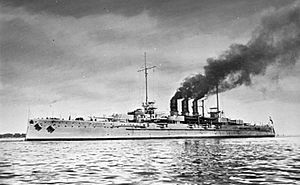SMS Helgoland facts for kids
style="width: 315px; border-spacing: 2px; margin-bottom: 10px;"

SMS Helgoland c. 1911–1917
|
|
Quick facts for kids History |
|
|---|---|
| Name: |
Helgoland |
| Builder: |
Howaldtswerke, Kiel |
| Laid down: |
11 November 1908 |
| Launched: |
25 September 1909 |
| Commissioned: |
23 August 1911 |
| Fate: |
Scrapped in 1921 |
| General characteristics | |
| Class and type: |
Helgoland-class battleship |
| Displacement: |
|
| Length: |
167.20 m (548 ft 7 in) |
| Beam: |
28.50 m (93 ft 6 in) |
| Draft: |
8.94 m (29 ft 4 in) |
| Installed power: |
27,617 ihp (20,594 kW) |
| Propulsion: |
|
| Speed: |
20.8 knots (38.5 km/h; 23.9 mph) |
| Range: |
5,500 nautical miles (10,190 km; 6,330 mi) at 10 knots (19 km/h; 12 mph) |
| Complement: |
|
| Armament: |
|
| Armor: |
|
The SMS Helgoland was a powerful warship known as a dreadnought battleship. It was the first ship in its group, called the Helgoland-class, built for the German Imperial Navy. This ship was an improved version of an earlier design, the Nassau class, with bigger main guns.
Helgoland was built in Kiel, Germany, starting on November 11, 1908. It was officially launched into the water on September 25, 1909. The ship was ready for duty and joined the navy on August 23, 1911.
During World War I, Helgoland was involved in several important battles. It fought against the British Royal Navy in the North Sea and also against the Russian Navy in the Baltic Sea. One of its most famous battles was the Battle of Jutland in May–June 1916. After the war ended, Helgoland was given to Great Britain and taken apart for scrap metal in the early 1920s. Today, its special coat of arms can be seen at the Military History Museum of the Bundeswehr in Dresden, Germany.
Contents
What Was the SMS Helgoland?
The SMS Helgoland was a type of warship called a battleship. Battleships were the largest and most heavily armed ships of their time. They were designed to fight other big ships.
The Helgoland was part of the "dreadnought" era. This means it was a very modern battleship for its time. It had many large guns all of the same size.
Building a Giant Ship
Building a battleship like Helgoland was a huge task. It took many years and a lot of people to complete.
- The ship was started on November 11, 1908. This is called "laid down."
- It was launched into the water on September 25, 1909. This is when the ship first touched the water.
- Finally, it was ready for service on August 23, 1911. This is when it was "commissioned" into the navy.
The Helgoland was built by a company called Howaldtswerke in Kiel, Germany. This shipyard was famous for building powerful ships.
Battles and Adventures
The SMS Helgoland saw action during World War I. It was an important part of the German fleet.
North Sea Missions
Helgoland was part of the I Scouting Group. This group often patrolled the North Sea. They watched for enemy ships, especially from the British Royal Navy.
Baltic Sea Operations
The ship also spent time in the Baltic Sea. Here, it faced the Russian Navy. One notable event was the Battle of the Gulf of Riga in August 1915.
The Battle of Jutland
The Battle of Jutland was one of the biggest naval battles in history. It happened from May 31 to June 1, 1916. Helgoland was right in the middle of this huge fight.
The battle involved hundreds of ships from the British and German navies. Helgoland and its crew fought bravely during this intense conflict.
End of an Era
After World War I ended, many German warships were given to the winning countries. The SMS Helgoland was one of these ships.
It was handed over to Great Britain. In the early 1920s, the ship was broken down for scrap metal. This means its parts were recycled.
Even though the ship itself is gone, its history lives on. The ship's coat of arms, a special symbol, is now in a museum in Dresden. It reminds people of the Helgoland and its role in history.

